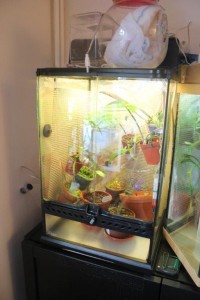There is still time in June to sow fast maturing vegetables in areas affected by late frosts, and affected by the erratic weather. Spring onions, parsley and other salads that are harvested successionally can be sown regularly until August, to make full use of the growing season. Those needing warm soil like Florence Fennel, Courgettes and French and Runner beans, can be sown direct into the soil, too, ideally, early in the month. While you are sowing, it is also time to be thinking ahead to winter! Sprouting broccoli, Brussels sprouts and autumn and winter cauliflowers can be transplanted from trays in the greenhouse into thoroughly prepared beds. There is also plenty to harvest, so enjoy the fruits of your labour! Pick podded crops like French and broad beans regularly as harvesting encourages them to continue flowering, and extends the cropping season.
Be vigilant as pests and diseases abound, though this year’s Hostas are remarkably slug free – so far! Check plants daily if you can, it is much better to control problems before they are established and cause damage to your plants. Small populations of aphids can be squashed, as can Lily beetle, which can decimate your plants overnight. Check plants morning and evening for lily beetle. When you go to catch them, first put your hand underneath the leaf, their defence mechanism is to drop off the leaf, then scuttle away and escape only to wreak more devastation later on!
Everything is so late this year, I am still waiting to put some tender plants outdoors, though they will soon have to go out whatever the weather, to make space for the greenhouse tomatoes. Once the first truss appears, I’ll be transplanting them into 12” pots, to give the soil in the greenhouse border a rest. It’s advisable to change the soil every three or four years, so devise your own rotation system There is also the option of growing them in a form of ‘ring culture’, cutting the base from a plastic pot, which sits on a growing bag, in a hole the same shape as the base of the pot.
 This creates a two tier root system, the plant is fed by watering into the pot and watered by watering the growing bag through holes cut in the side of the bag – I normally put a small flower pot in each hole to help with watering. It is also important to remove the side shoots which appear where the base of the leaf joins the main stem. Break them off with your finger and thumb when they are about 2.5cm long. It is a pleasant, leisurely occupation for a Sunday afternoon! It is also important to keep the compost moist but not waterlogged, using tepid water. Growing greenhouse tomatoes in pots, borders or using the method described above, it is much easier to keep them watered correctly; the moisture levels in growing bags tend to fluctuate between being too wet or too dry. Keeping them properly watered is one of the keys to success, as irregular watering leads to fruit splitting or blossom end rot, when the base of the tomato becomes flat and brown.
This creates a two tier root system, the plant is fed by watering into the pot and watered by watering the growing bag through holes cut in the side of the bag – I normally put a small flower pot in each hole to help with watering. It is also important to remove the side shoots which appear where the base of the leaf joins the main stem. Break them off with your finger and thumb when they are about 2.5cm long. It is a pleasant, leisurely occupation for a Sunday afternoon! It is also important to keep the compost moist but not waterlogged, using tepid water. Growing greenhouse tomatoes in pots, borders or using the method described above, it is much easier to keep them watered correctly; the moisture levels in growing bags tend to fluctuate between being too wet or too dry. Keeping them properly watered is one of the keys to success, as irregular watering leads to fruit splitting or blossom end rot, when the base of the tomato becomes flat and brown.
Happy Gardening! Matt










